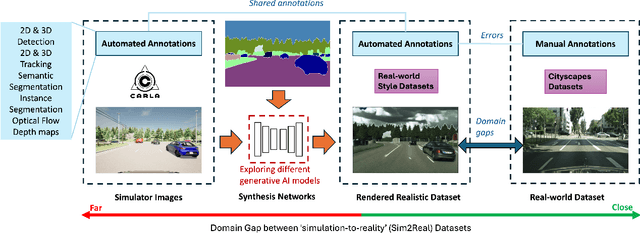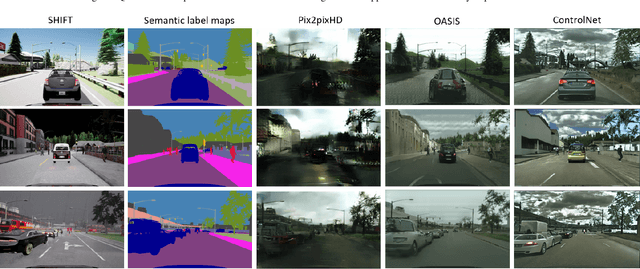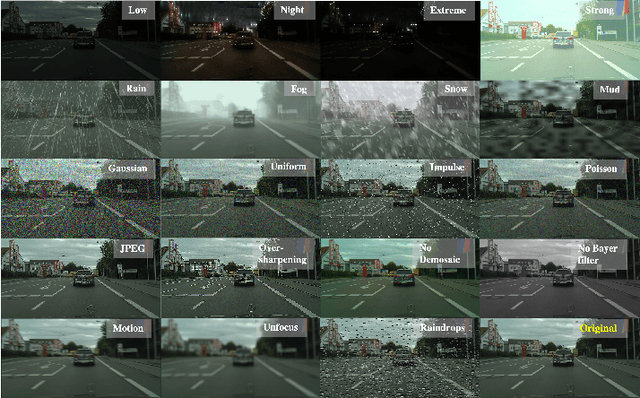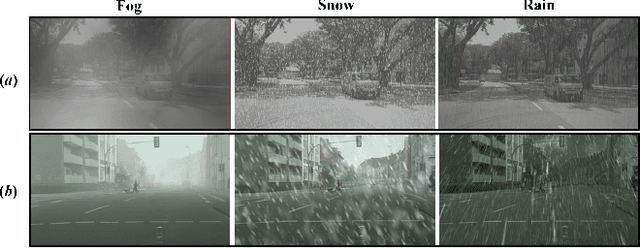Valentina Donzella
Exploring Generative AI for Sim2Real in Driving Data Synthesis
Apr 14, 2024



Abstract:Datasets are essential for training and testing vehicle perception algorithms. However, the collection and annotation of real-world images is time-consuming and expensive. Driving simulators offer a solution by automatically generating various driving scenarios with corresponding annotations, but the simulation-to-reality (Sim2Real) domain gap remains a challenge. While most of the Generative Artificial Intelligence (AI) follows the de facto Generative Adversarial Nets (GANs)-based methods, the recent emerging diffusion probabilistic models have not been fully explored in mitigating Sim2Real challenges for driving data synthesis. To explore the performance, this paper applied three different generative AI methods to leverage semantic label maps from a driving simulator as a bridge for the creation of realistic datasets. A comparative analysis of these methods is presented from the perspective of image quality and perception. New synthetic datasets, which include driving images and auto-generated high-quality annotations, are produced with low costs and high scene variability. The experimental results show that although GAN-based methods are adept at generating high-quality images when provided with manually annotated labels, ControlNet produces synthetic datasets with fewer artefacts and more structural fidelity when using simulator-generated labels. This suggests that the diffusion-based approach may provide improved stability and an alternative method for addressing Sim2Real challenges.
Taming Transformers for Realistic Lidar Point Cloud Generation
Apr 08, 2024



Abstract:Diffusion Models (DMs) have achieved State-Of-The-Art (SOTA) results in the Lidar point cloud generation task, benefiting from their stable training and iterative refinement during sampling. However, DMs often fail to realistically model Lidar raydrop noise due to their inherent denoising process. To retain the strength of iterative sampling while enhancing the generation of raydrop noise, we introduce LidarGRIT, a generative model that uses auto-regressive transformers to iteratively sample the range images in the latent space rather than image space. Furthermore, LidarGRIT utilises VQ-VAE to separately decode range images and raydrop masks. Our results show that LidarGRIT achieves superior performance compared to SOTA models on KITTI-360 and KITTI odometry datasets. Code available at:https://github.com/hamedhaghighi/LidarGRIT.
Benchmarking the Robustness of Panoptic Segmentation for Automated Driving
Feb 23, 2024



Abstract:Precise situational awareness is required for the safe decision-making of assisted and automated driving (AAD) functions. Panoptic segmentation is a promising perception technique to identify and categorise objects, impending hazards, and driveable space at a pixel level. While segmentation quality is generally associated with the quality of the camera data, a comprehensive understanding and modelling of this relationship are paramount for AAD system designers. Motivated by such a need, this work proposes a unifying pipeline to assess the robustness of panoptic segmentation models for AAD, correlating it with traditional image quality. The first step of the proposed pipeline involves generating degraded camera data that reflects real-world noise factors. To this end, 19 noise factors have been identified and implemented with 3 severity levels. Of these factors, this work proposes novel models for unfavourable light and snow. After applying the degradation models, three state-of-the-art CNN- and vision transformers (ViT)-based panoptic segmentation networks are used to analyse their robustness. The variations of the segmentation performance are then correlated to 8 selected image quality metrics. This research reveals that: 1) certain specific noise factors produce the highest impact on panoptic segmentation, i.e. droplets on lens and Gaussian noise; 2) the ViT-based panoptic segmentation backbones show better robustness to the considered noise factors; 3) some image quality metrics (i.e. LPIPS and CW-SSIM) correlate strongly with panoptic segmentation performance and therefore they can be used as predictive metrics for network performance.
Contrastive Learning-Based Framework for Sim-to-Real Mapping of Lidar Point Clouds in Autonomous Driving Systems
Dec 25, 2023



Abstract:Perception sensor models are essential elements of automotive simulation environments; they also serve as powerful tools for creating synthetic datasets to train deep learning-based perception models. Developing realistic perception sensor models poses a significant challenge due to the large gap between simulated sensor data and real-world sensor outputs, known as the sim-to-real gap. To address this problem, learning-based models have emerged as promising solutions in recent years, with unparalleled potential to map low-fidelity simulated sensor data into highly realistic outputs. Motivated by this potential, this paper focuses on sim-to-real mapping of Lidar point clouds, a widely used perception sensor in automated driving systems. We introduce a novel Contrastive-Learning-based Sim-to-Real mapping framework, namely CLS2R, inspired by the recent advancements in image-to-image translation techniques. The proposed CLS2R framework employs a lossless representation of Lidar point clouds, considering all essential Lidar attributes such as depth, reflectance, and raydrop. We extensively evaluate the proposed framework, comparing it with state-of-the-art image-to-image translation methods using a diverse range of metrics to assess realness, faithfulness, and the impact on the performance of a downstream task. Our results show that CLS2R demonstrates superior performance across nearly all metrics. Source code is available at https://github.com/hamedhaghighi/CLS2R.git.
 Add to Chrome
Add to Chrome Add to Firefox
Add to Firefox Add to Edge
Add to Edge